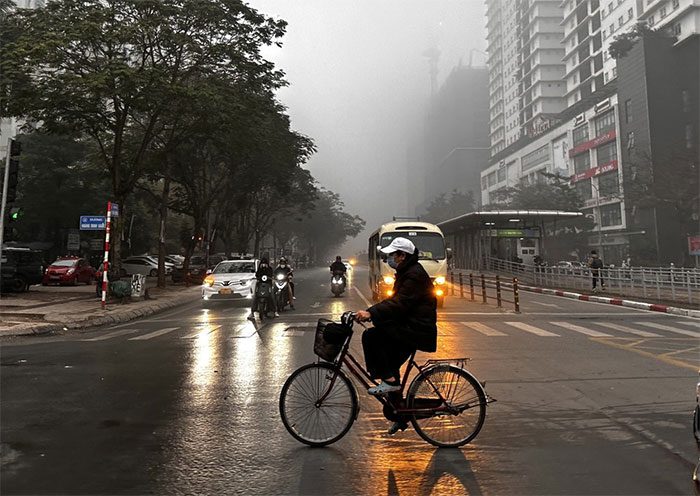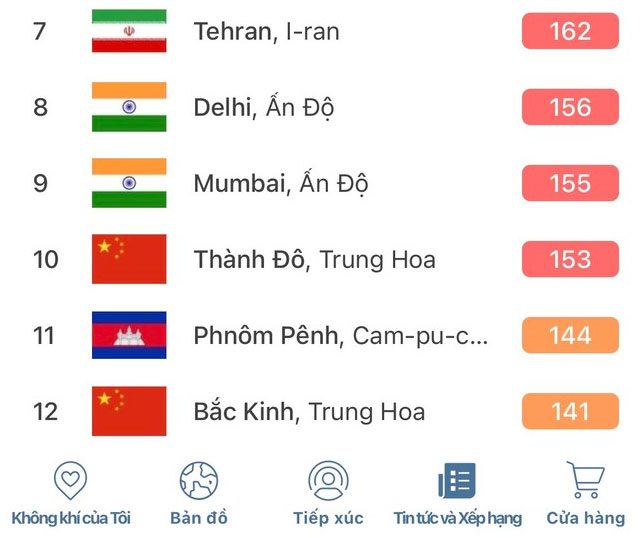The air quality monitoring application Air Visual reported that Hanoi was the most polluted city in the world this morning (March 5), surpassing pollution hotspots such as Lahore in Pakistan and Dhaka in Bangladesh.
At 7:18 AM, the Air Quality Index (AQI) for Hanoi was measured at 241, falling into the purple category – which is extremely harmful to the health of all individuals, with recommendations for people to limit outdoor activities.
With this index, Hanoi is recognized as the most polluted city in the world this morning and is also the only city reaching the purple level of pollution among over 100 cities monitored by Air Visual.
Air quality monitoring applications from the Department of Environmental Pollution Control under the Ministry of Natural Resources and Environment also noted widespread pollution in Hanoi and provinces with many industrial zones such as Bac Ninh and Hung Yen.
The majority of pollution points were in the red and purple levels, with a particular measurement at the People’s Committee of Xuan Lam Commune, Thuan Thanh District, Bac Ninh Province reporting hazardous air quality (the most dangerous level due to air pollution) this morning with an AQI of 347. This measurement is close to the Ha Man – Tri Qua Industrial Park.
The PAM Air monitoring application – currently the largest air monitoring network in Vietnam, reported that pollution is widespread across Hanoi and the northern delta provinces, with pollution commonly at the purple level, which is extremely harmful to the health of all individuals.

Hanoi experiences severe air pollution this morning. (Photo: Nhu Y).
The air quality monitoring application of the U.S. Embassy indicated that the severe pollution might last until tomorrow. From March 7, a northeast monsoon is expected to arrive, potentially improving air quality.
The Department of Environmental Pollution Control advises residents to regularly monitor air quality to proactively mitigate the impacts caused by air pollution.
The Ministry of Health recommends that during days of severe air pollution, residents should limit going outside, engage in outdoor exercise, and labor when air quality is poor. When outdoors, it is advisable to wear quality masks and ensure they fit properly (tight and secure on the face).
Clean the nose and gargle morning and night with saline solution, especially after being outdoors. Rinse the eyes with saline solution in the evening before going to bed.


Air Visual reports Hanoi as the most polluted city in the world at 7:18 AM this morning.
For smokers, it is advisable to quit or significantly reduce smoking. Non-smokers should avoid exposure to cigarette smoke. It is also recommended to limit opening windows and doors during times of heavy air pollution, especially for families near traffic routes or in polluted areas.
Regularly clean living spaces and homes, ensuring a well-ventilated environment. Reduce or replace the use of charcoal stoves, wood, and straw with electric, induction, or gas stoves. Planting green trees in and around the house can help block dust and purify the air.
For individuals with respiratory diseases, chronic obstructive pulmonary disease, cardiovascular issues, malnutrition, the elderly, the Ministry of Health recommends implementing preventive measures more strictly. Additionally, it is advised to minimize outdoor activities, particularly during times of heavy air pollution.
The air pollution in Hanoi and northern provinces is primarily due to PM2.5 fine dust – a type of particulate considered deadly in the air due to its ability to penetrate deep into the lungs, causing various respiratory and cardiovascular diseases.
According to the Global Burden of Disease Study 2019 (IMHE, 2019), air pollution ranks fifth among the leading risk factors for death and disability in Vietnam, following causes such as hypertension, blood sugar, smoking, and diet.
Air pollution has been an environmental issue in Hanoi and the Red River Delta provinces for many years. There are four major groups of causes identified: traffic activities, industrial – craft villages, construction, and residential activities like burning waste and straw.
Air pollution in northern Vietnam typically peaks during the winter (from October of the previous year to March of the following year) due to unfavorable weather conditions that cause pollutants, mainly fine dust, to concentrate close to the ground. In the summer, rainfall combined with strong winds helps improve air quality.



















































